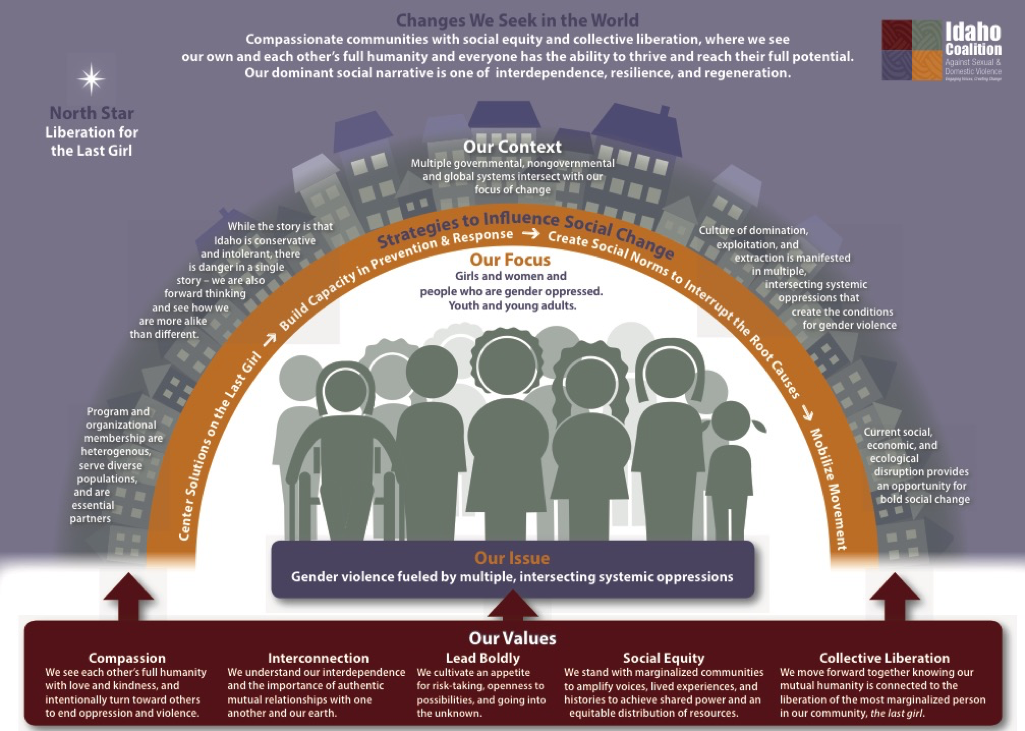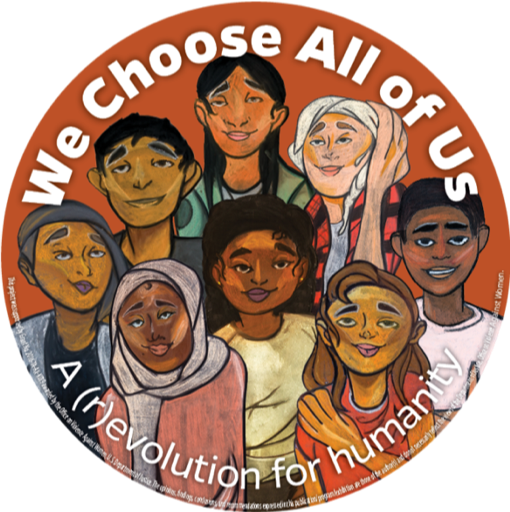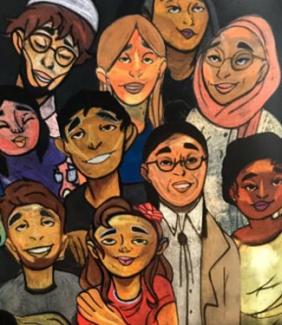By Kelly Miller and Micaela Ríos Anguiano with the Idaho Coalition Against Sexual & Domestic Violence
In 2014, the Idaho Coalition Against Sexual & Domestic Violence (Idaho Coalition) began to lay a foundation for movement building. The catalyst for our internal transformation was Move to End Violence, a national initiative to build a cross-cutting social justice movement. Kelly Miller, our executive director, participated in a two-year cohort experience, illuminating numerous hard truths about our mainstream movement work – from the ways we centered our work on white, heterosexual, able-bodied, temporarily poor women to the upending truth that we were a project factory (deliverable after deliverable) rather than a movement builder.
We began to understand that the root causes of violence are inextricably interconnected and that we could not end gender violence unless we also worked to end patriarchy, sexism, racism, nationalism, classism, homophobia, transphobia, able-ism, audism, anti-semitism, religious discrimination, and xenophobia/anti-immigrant sentiment and all the ways we devalued and “othered” human beings based on identities (for definitions of terms, see here, here and here). To end gender violence, we knew we had to address the larger systemic issues that generate and sustain a culture of violence.
Our journey has revealed that domination, extraction, and violence is rooted in our disconnection from our body and our spirit, our disconnection from one another and the earth. We now understand that disconnection is a tool of colonization – disconnection from a sense of self, the culture of place, spirituality, and our ancestral roots; and that disconnection fuels systems that serve to accumulate wealth and power in the hands of a few. Our journey has transformed and continues to transform ourselves first, and then our organization from the inside out.
Theory of Change
To move from theory to action, over the course of nine months, we needed a tool to encapsulate common language and allow us to organize our thoughts, re-imagine and make sense of abstract concepts like liberation, and assess our assumptions. We needed to build on the knowledge, research, and experience of gender violence and integrate systemic oppressions (racism, classism, homophobia, able-ism and adultism) in creating real solutions. We wanted to change the discussion from “what we do” to “what is the change we want to see in the world we want to live in.” We wanted a tool that could be foundational and aspirational – that would situate the organization for social change and could be operationalized across the organization.
“This is a time of (r)evolution for humanity, a time to plant and nurture the seed that reconnects us to us. Together, we can create and manifest hope – the hope grounded in truth-telling, in seeing what it is and what it can be, what it will be – a world where everyone is valued, everyone is safe, and everyone can thrive.” – Idaho Coalition
Over a nine-month-period, Idaho Coalition leadership and support staff, board, partners and community members developed a theory of change with the support of a consultant. The theory of change encompasses a one-page graphic that serves as an identity and foundational tool for the organization’s future efforts, including decision-making, communications, recruitment/hiring, initiative design, partnerships, and evaluation.

Idaho Coalition’s theory of change identifies “Liberation for the Last Girl” as the North Star, which is the embodiment of our vision, values, and purpose. The “last girl” concept means centering the people or communities who are most marginalized by society across our work, so the solutions we imagine can work for them. When we intentionally center solutions on historically marginalized communiites, then the root causes of violence will likely have been addressed for all.
It is a living document that evolves over time. “Changes We Seek in the World: Compassionate communities with social equity and collective liberation, where we see our own and each other’s full humanity and everyone has the ability to thrive and reach their full potential. Our dominant social narrative is one of interdependence, resilience, and regeneration.” – Idaho Coalition
Through this theory of change, we were able to identify our focus – gender violence interconnected to systemic oppressions. By defining and articulating our core organizational values, we have been able to integrate a thinking-action-mind approach paired with a feeling-relational-heart approach.
We identified the four approaches or strategies for social change we wanted to implement across the organization – centering solutions on historically marginalized communities, building capacity in prevention and response, creating new social norms to interrupt violence and movement building.
Movement Building – Build a Bigger We
While the dominant story is that Idaho is conservative, white, and intolerant, we have been tapping into the hunger of activists and emerging activists across generations, communities, and social justice issues ready to work together for another world and way of being. People are mobilizing across Idaho and are central to transformative organizing efforts.
To build our internal capacity for movement building, we needed to build authentic relationships with leaders and organizations across our state connected to and rooted in historically marginalized communities and across social justice issues. These deepened relationships, based in mutuality and trust, allow for the Idaho Coalition to ensure the voice and experiences of historically marginalized communities are centered in our work. Across the state we are building authentic relationships with Black, Indigenous, Latinx, immigration, LGBTQ, refugee resettlement, faith-based, and disability advocacy leaders, influencers, and organizations.
 Over the last few years, the social, economic, and ecologic disruption has required and created opportunities for increase interconnectedness through community and transformative culture shifts. There is a hunger and readiness among youth and adults to generate a culture that interrupts violence and domination and creates life-affirming ways of being that center liberation, equity, wholeness, and our interconnectedness and interdependence.
Over the last few years, the social, economic, and ecologic disruption has required and created opportunities for increase interconnectedness through community and transformative culture shifts. There is a hunger and readiness among youth and adults to generate a culture that interrupts violence and domination and creates life-affirming ways of being that center liberation, equity, wholeness, and our interconnectedness and interdependence.
As a result, the cross-movement We Choose All of Us communities of practice is amplifying the power of community stories, deep listening, and putting values into practice. Our youth and multi-generational movement-building work inspires what is possible for the rest of the country. We are upending the narrative with thousands of people at rallies and are generating hopeful headlines in national news like "Even in Red States…."
Over the last few years, we have embodied the idea of “what you pay attention to grows.” We learned and began to embody the four elements of movement building from the Movement Strategy Center: 1) Vision & Purpose – Emergent Worldview; 2) Deep Embodiment of Practice; 3) Radical Connection and Community, and 4) Strategic Navigation.
1) Vision and Purpose
Our vision is compassionate communities with social equity and collective liberation, where we see our own and each other’s full humanity, and everyone can thrive. Our dominant social narrative is one of interdependence, resilience, and regeneration. Our vision is collective thriving. Our purpose is to end gender violence and systemic oppression by seeding new ways of being toward an emergent worldview, the world we want to live into now and into the future.
2) Deep Embodiment of Practice
How we are is as important, if not more so, than what we do. Transformative movement building requires new or reclaimed ways of being that embody our full humanity and live into our values.
We understand the importance of identifying habits – unconscious, repetitive acts that are tied to colonization and white supremacist culture – like urgency, perfection, the value of the written word, busy-ness. Most importantly, we are learning how conscious practices such as low and s-l-o-w breathing together can help us expand our capacity and humanity.
We have adopted the four principles and practices of Forward Stance – stance, broad awareness, rhythm, and energy – as essential practices across the organization and are seeing firsthand how they can be used to create transformative movements.
3) Radical Connection and Community
 Relationships and community are central to our movement building. We embrace the art of gathering and consider all the ways we can create a sense of belonging – grounding through collective breathing or cultural practices led by the specific community, sitting in a circle, storytelling, providing healthy foods, playing music that reflects the purpose, co-creating an altar specific to your community by asking everyone to bring an item, and more.
Relationships and community are central to our movement building. We embrace the art of gathering and consider all the ways we can create a sense of belonging – grounding through collective breathing or cultural practices led by the specific community, sitting in a circle, storytelling, providing healthy foods, playing music that reflects the purpose, co-creating an altar specific to your community by asking everyone to bring an item, and more.
We also explore new ways of being that acknowledge the need for the repair of past harms and create a culture of accountability. And we know that we need to move with those who are open, ready, and willing to live into new ways of being.
4) Strategic Navigation
Movement Strategy Center poses three questions to guide our strategic navigation:
- What does our purpose lead us to?
- What will best take us towards the vision for the world we want?
- How do we practice our values in this choice?
It’s essential that we find new ways of strategic navigation that reject hierarchies and systems of domination that no longer serve us. We also understand the power of leveraging multiple strategies toward the same vision and purpose.
Movement Building Impact
 Shifts are evident from the significant increase in the number of people at marches that we organize or provide support to – over 7,000 at the initial Idaho Women’s March, 5,000 at the Separation of Families Rally, and the support letter by the Idaho Coalition youth activists on Change.org for Christine Blasey Ford, PhD during the Kavanaugh hearing, generating over 117,000 signers and significant national media coverage, and the Ms. Foundation Free to Be You & Me Award for the Idaho Coalition and our three youth activists.
Shifts are evident from the significant increase in the number of people at marches that we organize or provide support to – over 7,000 at the initial Idaho Women’s March, 5,000 at the Separation of Families Rally, and the support letter by the Idaho Coalition youth activists on Change.org for Christine Blasey Ford, PhD during the Kavanaugh hearing, generating over 117,000 signers and significant national media coverage, and the Ms. Foundation Free to Be You & Me Award for the Idaho Coalition and our three youth activists.
We are now evolving toward movement building for collective thriving for those who are ready, willing and open to cultivate practices such as spaciousness, connection, and abundance, build beloved community and disrupt dominant narratives through storytelling. Through these practices we will begin to see ourselves reflected in the lives of others and begin to understand our own humanity on a deeper level that creates a change and shift in our arc that interrupts the dominant narrative, embodied indigeneity, and live into new ways of being for decades and generations to come.
Join us at our Collective Thriving conference on December 4-5, where we will explore ways to repair the harm from our culture of domination, extraction, and violence and re-imagine a world rooted in interdependence, resilience, and regeneration!
“Transformative movement builders imagine the path forward to possible futures we cannot yet see. We lead others to share in this vision and contribute to a larger purpose. Our dreams are rooted in the wisdom of the past, with awareness of the present, and hope for the future.” - Movement Strategy Center
#1Thing, One Movement: Working Together Towards Collective Liberation
This October, the Domestic Violence Awareness Project has chosen the theme, #1Thing, One Movement, challenging each of us to identify new ways to move forward together toward our common vision. What are some concrete ways that you can work to “build a bigger we” during Domestic Violence Awareness Month and Beyond? Learn more here and share your #1Thing for one movement with @NRCDV.
“#1Thing is about harnessing the momentum of our movements – especially at their critical points of intersection – by calling people to specific and direct collective action that are informed by the communities most directly impacted.” – Awareness + Action = Social Change: What’s Your #1Thing?, 2018















